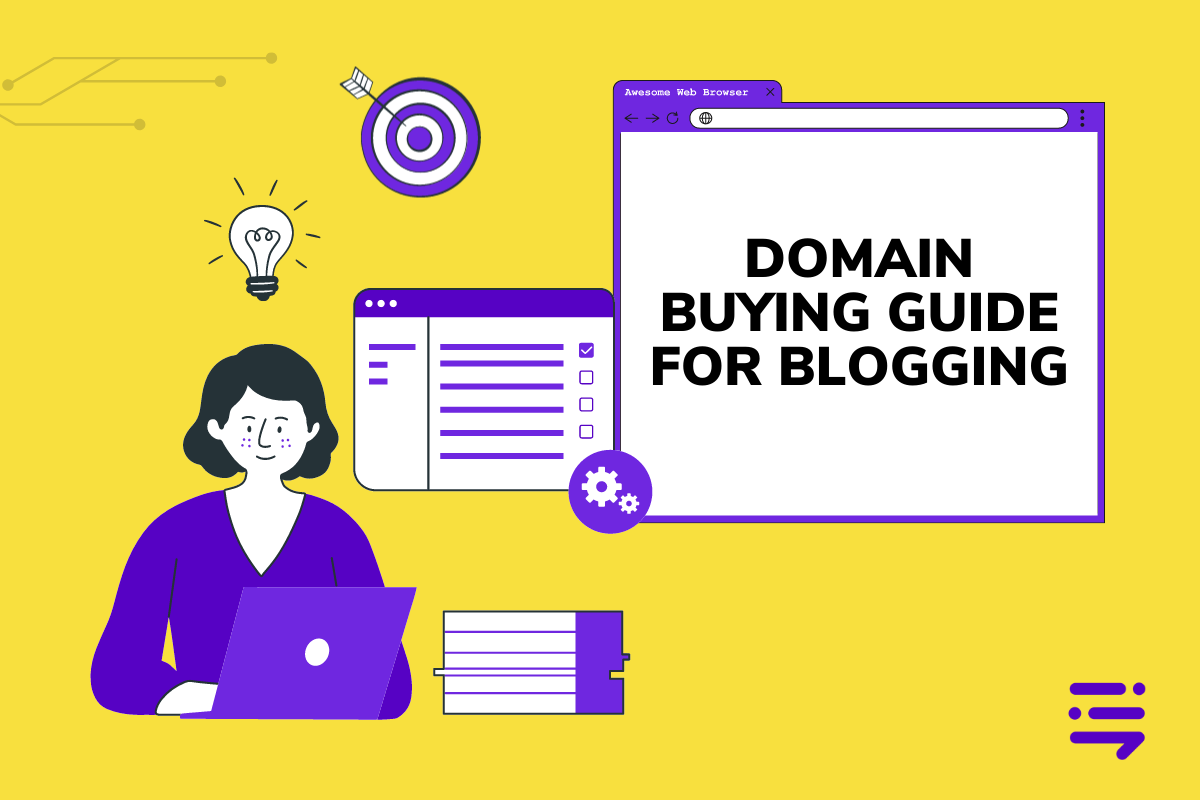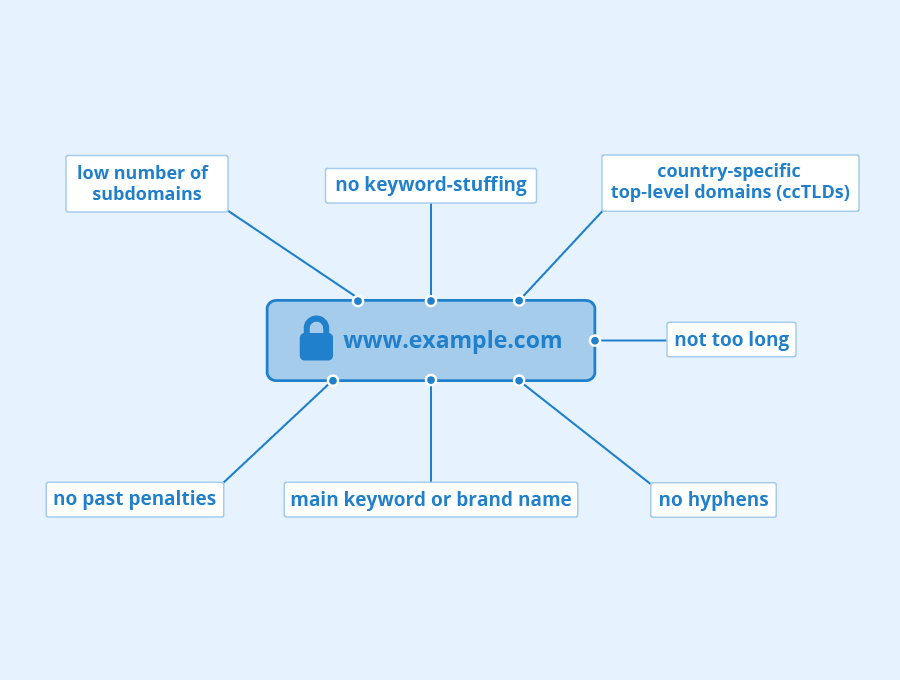Discover top guides, trends, tips and expertise from AIO Writers
Domain Buying Guide for Blogging: Choosing the Perfect Name
Julia McCoy
Monday, 24th Apr 2023
A domain name is the first step in building a recognizable brand online. It gives customers an easy way to remember who you are and what your business does. Search engines like Google also rank websites higher if they have a good domain name – meaning more visibility for your brand.
A good domain name should be short enough for people to remember but long enough for potential customers to understand what your website is about when they see your URL. Plus, having an easy-to-remember web address makes it simpler for visitors to share your domain URL with others.
There are 661,727,134 registered domains today, and 37% of them are dot coms. So how do you choose a domain name that’s unique and memorable?
In this domain buying guide for blogging, you will learn how to choose the right domain name that aligns with your niche and target audience. You’ll also learn how to assess domain availability and buy a domain name from reliable registrars.
Table of Contents
What is a Domain Name?
A domain name is a unique identifier for websites on the internet. It’s used to identify and locate computers, networks, and other resources connected to the World Wide Web.
The domain name system (DNS) helps users find their way around the web by translating human-readable addresses into numerical IP addresses that are more easily understood by computers.
Domain names typically consist of two parts: A top-level domain (TLD) such as .com or .org, followed by a second-level domain.
For instance, in the domain name www.example.com, “example” is the second-level domain, and “.com” is the TLD.
Some domains may also include subdomains such as “blog.example.com” where “blog” is the subdomain.
Does the extension matter to your blog?
Yes, it does. Different extensions have different levels of trust associated with them.
For example, a .com domain is considered the most trusted and credible in many countries around the world. It’s seen as a sign of legitimacy and professionalism for businesses. On the other hand, country-specific domains such as .uk or .ca are seen as more trustworthy by local customers because they know that these domains are reserved for businesses based in their respective countries.
The domain extension you choose can also impact SEO performance. Search engines may give higher rankings to websites with certain extensions due to increased credibility and trustworthiness associated with those extensions, so it’s important to do your research before deciding on which one you should use for your website.
Finally, the cost is another factor when choosing an appropriate domain extension for your business needs. Some top-level domains like .com or .org will usually be more expensive than country-specific TLDs like .uk or .ca – but depending on where you want to target customers, this could end up being worth it in terms of search engine visibility and customer confidence in your brand.
Selecting a domain name for your blog is a critical decision that can set you apart from other bloggers and create a lasting online impact. Now let’s look at how to choose a domain name for your website.

Image source: Seobility
How to Choose a Domain Name for Your Blog
When choosing a blog domain, there are several factors to consider. Here are 10 easy steps for choosing a good domain name for your blog.
1. Research Your Niche
Before you can choose a domain name, it’s important to research your niche and get an idea of what kind of content you will be creating. Look at the competition in your industry and find out what keywords they are using in their domain names. This will give you an idea of how competitive the market is and help you come up with ideas for a unique domain name that stands out from the crowd.
2. Brainstorm Ideas
Once you have done some research on your niche, it’s time to start brainstorming potential domain names for your blog or website.
Make sure your blog’s domain name corresponds to your blog content. Pick something that reflects your brand or topic so people know what they’re getting when they visit your site. This could mean using words related to your industry or incorporating keywords relevant to what you are writing about.
3. Consider Domain Extensions
When choosing a domain name for your blog, don’t forget to consider different extensions such as .com, .net, or .org, which all have slightly different meanings and implications. Make sure you pick one that suits the purpose of your blog.
4. Keep It Short and Sweet
Shorter domains tend to rank higher than longer ones since they are easier for people (and search engines) to remember, so try not to use too many words. Also avoid hyphens (-), numbers (#), and other special characters (!@#$%^&*) as these symbols can make it harder for visitors to remember your website address and might even lead them to another site!
5. Avoid Trademarks and Copyrighted Material
Make sure none of the words in your domain name infringes on trademarks owned by another person or company. You could land in hot water if you violate intellectual property rights so always double-check before committing to a domain name.
Steer clear from copyrighted material such as popular movie titles and characters as this may result in legal action.
6. Be Unique and Memorable
When deciding on a blog domain name, think about how your website address will stand out from competitors. You can use puns or wordplay to make your blog name memorable. Being creative here will pay off long-term, especially once your domain name and brand gain visibility.
7. Don’t Rush It
You should take your time choosing an appropriate domain name. Remember, this will be your blog’s permanent address on the Internet and you can’t change it once it’s registered. If you change your mind later on, you will lose all that traffic you built up over time and you’ll have to start all over again.
8. Use Keywords Wisely
If possible, try to include specific keywords related to your blog niche within the URL itself. This will help boost your website’s SEO rankings even further.
9. Secure Social Media Handles Too
For branding purposes, try to secure the same social media handles to match your blog name. Create an account on Facebook, Twitter, Instagram, and other social networks with the same name before somebody else claims them.
10. Check Availability
Finally, check the availability of your chosen domain name before committing. Many popular terms have already been taken so do some research first before settling on a particular name.
One overlooked aspect of domain investing is the importance of a memorable and easy-to-spell domain name. Don't underestimate the value of a domain that is easy for people to remember and type correctly. #domaininvesting
— Frans Citroën (@franscitroen) January 9, 2023
Domain Buying Guide for Blogging
Checking Domain Name Availability
Once you’ve decided on a potential blog domain, you’ll need to check its availability before registering it. The first step in checking the availability of domain names is to use an online search tool such as Domainr or WhoisXMLAPI. These tools should give you an idea of whether someone else has already claimed your chosen URL.
It’s important to note that some popular domains may already be taken even though they don’t appear in these searches due to privacy settings put in place by the current owner. In this case, it may be possible to contact them directly about buying the domain from them instead of searching for another option.
Buying a Domain Name for Your Blog
Once you have found an appropriate domain name, the next step is to purchase it from an accredited registrar such as GoDaddy or NameCheap and configure DNS settings to point the new domain toward your web hosting account.
Most registrars offer different plans depending on the registration period, which is usually between 1-10 years. They typically cost around $10 to $15 per year.
Be sure to read over all of the terms and conditions before signing up. Some companies may charge extra fees if you make any changes after completing your registration.
Once you have registered your blog’s domain name, you might have to set up hosting to enable visitors to access and view your blog’s content. Popular options such as SiteGround and Bluehost offer reliable support teams along with other features like SSL certificates and email accounts included within their plans.
Generally speaking, shared hosting packages tend to be more cost-effective as multiple websites share resources from one server instead of having their own server space.
Buying a domain name can be an exciting process for any blogger. With the right steps and research, you can find the perfect domain that fits your blog’s goals and objectives.
The last step in our domain buying guide for blogging? Managing your domain name after you pick it out and purchase it.
Managing Your Domain Name After Purchase
Now that you have a URL for your blog, how do you manage your newly purchased domain name so you can ensure its long-term success?
- Keep track of the expiration date of your domain name so you can renew it before it expires.
- Ensure that all contact information associated with the domain name is current and correct, including administrative and technical contacts such as email addresses and phone numbers.
- Protect your domain from malicious activities like cyberattacks or phishing scams which could lead to its suspension or even deletion.
- To do this, consider setting up two-factor authentication (2FA) for added security when logging into your account as well as monitoring activity logs regularly for any suspicious activity taking place on your website or server hosting environment.
- It is essential to know the mechanics of DNS so you can modify records as needed without having to depend on paid outside sources like web hosts or DNS suppliers. Understanding how DNS works will also help prevent downtime due to misconfigurations which could cause visitors to leave.
Additional Reading: How to Make Money from Expired Domains
Follow This Domain Buying Guide for Blogging to Make the Best Choice
This domain buying guide for blogging summarizes the importance of having a great URL for your blog website. Follow these steps to choose a domain name and register it to prevent other people from taking control of your content. Once purchased, be sure to manage your domain name properly so that all information associated with it remains secure and up-to-date.
Overall, a great domain name is an integral piece to a cohesive, memorable brand. Don’t neglect the importance of choosing your domain name — and you won’t be sorry in the long run.

UNLOCK YOUR POTENTIAL
Long Headline that highlights Value Proposition of Lead Magnet
Grab a front row seat to our video masterclasses, interviews, case studies, tutorials, and guides.



